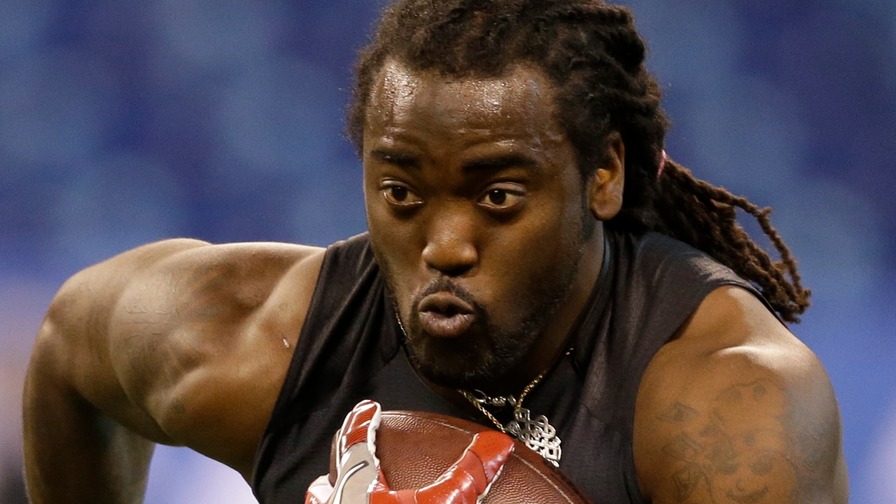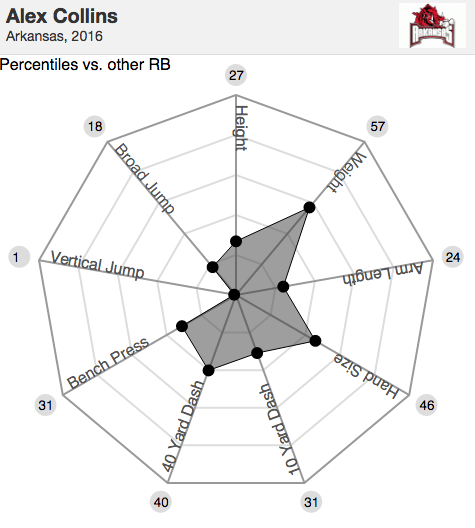Seattle Seahawks Continue to Develop a Committee in the Backfield with Alex Collins

Despite having undrafted rookie Thomas Rawls take the league by storm in 2015, the Seattle Seahawks have proven they have little faith in Rawls’ mirroring his success in 2016, as they have now selected former Notre Dame running back C.J. Prosise and Arkansas’ Alex Collins.
Seattle selected Collins with the 171st overall pick in the 2016 NFL draft, despite him being projected as a third or fourth round talent by NFL.com’s Lance Zierlein.
Meet Alex Collins
Collins, a three-year back at Arkansas, was named to the All-SEC Second Team by the coaches and media as a junior in 2015, as he finished third in the SEC in average rushing yards per game (121.37) and rushing touchdowns (20). He rushed for a total of 1,577 yards on 271 carries (5.82 yards per carry).
Compared to other running backs in this year’s class, Collins' height (5’10â€) and weight (217 pounds) both appear below average as seen here on his spider graph courtesy of MockDraftable.com. Also, Collins struggled to put up strong workout numbers at the 2016 NFL combine, which of course, only emphasized his lack of ideal measurables.

According to PlayerProfiler.com, Collins best compares to New Orleans Saints running back Vick Ballard, a former fifth-round pick out of Mississippi State who has struggled to get his career going due to a number of injuries. In addition to comparing Collins to Ballard, the guys at PlayerProfiler.com also have Collins beneath the 50th percentile in his 40-yard dash, Speed Score, Burst Score, Agility Score, and Bench Press.

Outside of his measurables, Collins is a downhill runner that will surprise defenses with his ability to both carry defenders on his back when running through traffic and make people miss in space. Though he is most highly regarded for his ability to bully his way through tackles with a lowered shoulder, Collins can avoid contact at times due in large part to the fact that his elusiveness is overlooked.
Also, Collins sets up his runs well because of his elite vision and patience in the backfield, as he rarely predetermines his running lane before the snap.
With just 27 receptions throughout his career at Arkansas, Collins lacks upside as a pass-catcher out of the backfield, while he also lacks good technique in pass protection.
Zierlein, a guy that traditionally steers away from judging a player based on his measurables, highlights Collins’ consistent production and the strong running back characteristics he put on display during his time with the Razorbacks.
“Collins is the epitome of consistency for over 1,000 yards and at least 5.4 yards per carry in each of his three seasons,†according to Zierlein. “Vision and footwork are the catalysts for his elusiveness and he has flashed long speed. Collins is a repetitive runner lacking dynamic talent, but he’s run in gap, power and zone schemes and should be a scheme for most teams looking at running back. Collins should be able to step right in and challenge for carries and red zone work immediately.â€
Collins Joins a Committee in Seattle
With Rawls, Christine Michael, and C.J. Prosise already ahead of him on the depth chart, Collins will face an uphill battle in terms of earning significant amount of carries within the Seahawks’ offense, but it seems certain that head coach Pete Carroll will run a committee in 2016.
Rawls carried the ball 147 times for 830 yards (5.6 yards per carry) and four touchdowns in wake of now retired running back Marshawn Lynch's injuries in 2015, via ESPN.com. Also, according to our numberFire Net Expected Points (NEP), Rawls earned the third-highest Rushing NEP (12.46) in 2015, but his numbers are due to drop given the added talent in the backfield.
Given the amount of success Rawls had behind the Seahawks’ below-average offensive line last year, Seattle’s committee of running backs could have an even easier time finding lanes in 2016 given their recent additions of former Texas A&M offensive tackle Germain Ifedi and former Boise State interior offensive linemen Rees Odhiambo.
Though Rawls will still get a bulk of the carries, Collins’ potential as a short-yardage back will likely force Rawls off the field when Seattle inches closer to the goal line. With that being said, Rawls’ average draft position should drop, while Collins will gain momentum due to his potential to become a touchdown thief in 2015.
















